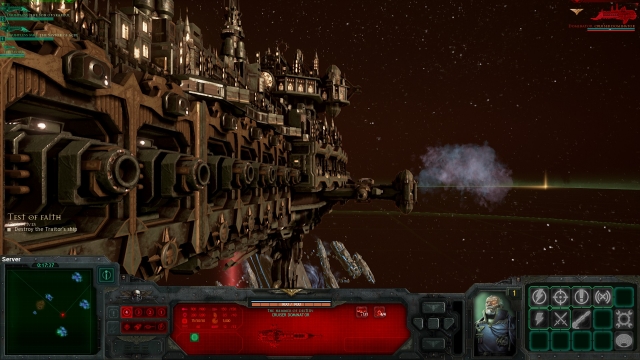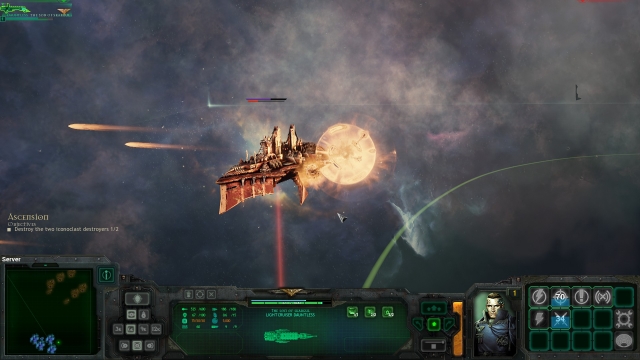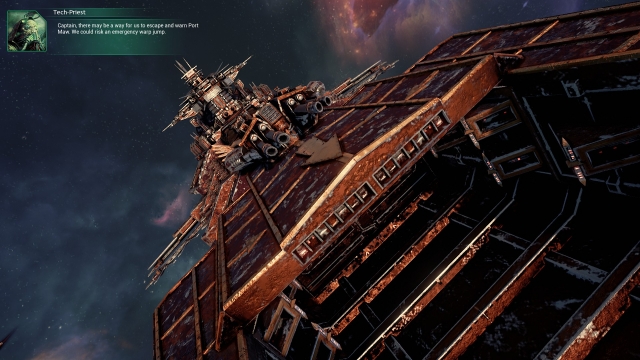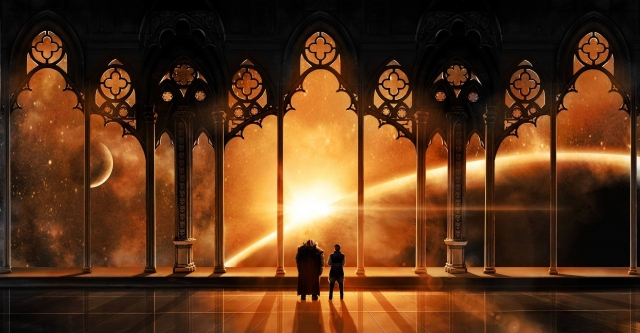
Battlefleet Gothic: Armada Review
Despite being set in a huge galaxy filled to the brim with warring factions, alien races and malevolent void-born demons, there have been surprisingly few games exploring the actual space side of the Warhammer 40,000 universe. This could be in part down to the fact Games Workshop has kept a vice-like grip on particular sections of its IP for a while, only relenting in the past few years amidst rumours of profit losses.
In these troubled times step forward Tindalos Interactive. The French firm has got its hands on the rights to make a game based on the Battlefleet Gothic board game, developed by Games Workshop in 1993 and discontinued in 2013. Keeping to the roots of the original tabletop format, the developers have created a space combat RTS with enough under the hood dice rolls to make a Dungeons & Dragons veteran feel dizzy while retaining the look and feel of an established universe where there is little room to manoeuvre creatively.
Battlefleet Gothic: Armada, as the name might imply to those aware of the lore, is set in the Gothic Sector of Imperial (human-controlled) Space. The sector is infamous for its close proximity to The Eye of Terror, a wormhole that feeds directly into The Warp - a demon and chaos-infected mirror of real space that occasionally spews forth hordes of enemies for a bit of looty-burny.
The campaign puts the player into the polished boots of Imperial Navy admiral Spire and tasks them with keeping control of the Gothic Sector - preventing rebellions, piracy and raiding - whilst trying to discover the secrets behind a new incursion by the forces of Chaos into human space. To do this, they’re given control of a fleet of cruisers (expanded as you grow in fame) designed with the mentality of if you have room, strap a gun onto it.

Needs more guns.
In the campaign, the gameplay is usually split between an overworld view of the different solar systems within the Gothic Sector - as well as which planets are close to rebellion, under attack etc - and an in-depth armoury screen where the player can customise their fleet to suit their needs. This second screen will become a familiar one as it features across all of Battlefleet Gothic’s modes from single player to multiplayer and skirmish. In it, players can spend the game’s currency: ‘renown points’ (earned by completing missions, defeating ships and keeping allies from harm) to purchase new ships, weapons and crew upgrades.
The armoury mode is expectedly deep and there is a satisfyingly varied selection of upgrades, modifications and bolt-ons that can be added onto the player’s ships. The amount of customisation is good to see, and in my time with the game I experimented with a number of different fleet layouts - from fast and maneuverable to ponderous and terrifyingly powerful - there is certainly room for a number of playstyles, even with just the Imperial Navy.
Battle in the game is played out over a flat plane, with some environmental hazards like asteroid fields and gas clouds thrown in for good measure. Some may be disappointed that full 3D combat isn’t an option, yet it’ll take all your nous to get the hang of it in its base form without having to deal with enemy ships attacking you from above and below.
While the arenas may be a little on the unimaginative side, Battlefleet Gothic makes up for this with a number of different objective types: sometimes you’ll be fighting a full-on deathmatch and other times you’ll be defending orbital stations or trying to break open a blockade. Playing as the defending or attacking sides in each mode feels different, meaning that there is an added layer of replayability, too.

Models and explosions look great
Yet, no matter the mode, you’ll have to get down to brass tacks and engage in some ship-to-ship combat. It’s here where the detail level of the game gets tested: does it live up to the tabletop game? The answer is yes. Each ship has an array of stats - from its hull integrity to its ability to fight off boarding actions to its morale and propensity for mutiny. All are displayed in a well-designed UI that allows quick and easy viewing. Before and during battle players are able to set engagement ranges depending on their ship’s weapons, as well as what sections of enemy vessels to target and which weapons systems to prioritise. This is all part and parcel for the player used to games like Sins of a Solar Empire and Homeworld but may confuse and intimidate players new to the stats-heavy RTS genre. The game does give the player a good three missions in which to get used to the mechanics in the campaign though, and leaves no stone unturned in showing all the bells and whistles available to a canny admiral.
Still, clashes between fleets for the new player will often be a flurry of button-presses, time slow-downs (using the game’s Combat Cogitator mechanic) and generally firing everything at everyone. The game is inherently complex and despite the hefty (and sometimes overwhelming) amount of tooltips Battlefleet Gothic throws your way, many players will have to feel things out for themselves. In most cases the game gives the player an ample amount of time to learn the ropes before things really start to get serious later in the game.
When it comes to representing an IP like Warhammer 40,000 there will always be two questions when it comes to graphics and “does it look good?” will nearly always be trumped by “does it look accurate?”. The answer to both for these questions in the case of Battlefleet Gothic is a resounding yes. Tindalos have really outdone themselves in turning the source material into a living, breathing world. Ship design is breathtaking - every nook and cranny of the vessels at your command is lovingly crafted and re-imagined, right up to the twinkling lights of the different decks on board.

Each race so far implemented into the game (Chaos, Eldar, Imperial and Orks) are instantly recognisable, with the developers imbuing each faction with enough character to give the player an idea of who they’re up against without having to consult tooltips or source material. Chaos fleets are misshapen mirrors of their Imperial enemies, dripping with occult sigils and signs and glowing with malevolence. Eldar ships are at once ethereal and salubrious, both majestic and fragile, much like their race. Ork ships, meanwhile, look exactly like what they are: hunks of metal strapped with as many rockets and weapons that their crew could find.
Battle between ships is a tableau of discharging weaponry, arcing missiles and fizzing laser-fire. Projectiles race across the screen with urgency and impact against shields and hulls with satisfying explosions or ripples of energy.
Warhammer 40,000 thrives on its depiction of the future not being a happy-shiny fairytale like Star Trek but on being something much more grim, dark and twisted. Tindalos Interactive have grabbed onto that with both hands and have created a truly grimy, rust and oil-washed reality in which the Imperium of Man struggles against its opponents.
Tindalos really pull out all the stops in the sound department, too. Employing a string of talented voice actors, the developers have managed to bring character and life to the universe in which the game is set. Imperials and Eldar are haughty and condescending while Chaos admirals are insidious and capricious. Ork captains are as expectedly gruff and menacing yet retain that hint of comic relief that make them fan favourites. The music is your usual bombastic affair to go along with the clashes between fleets and the sound effects for the ship’s sonorous volleys of gunfire are a joy to listen to. Don’t let the fact that there is no sound in space get between how great ship-to-ship combat feels in Battlefleet Gothic.

The game offers a host of options for the admiral wanting to take his fight elsewhere. Besides the campaign there is the single-player skirmish mode, which puts your fleet up against various randomised missions and enemies - the only goal is to get as far as possible.This mode is a rather welcome break from the campaign and is a great way of getting instantaneous action.
If fighting against other players is more of your thing then Battlefleet Gothic has a robust online mode, with easy access to match-ups and a ship selection system that means you’re not waiting too long for someone to customise their fleet. A word of warning, however: despite having played the game in its beta stage for my preview earlier this month, there was more than one occasion in which I was utterly obliterated online despite my experience. It goes to show that Battlefleet Gothic is easy to grasp and hard to master - which says a lot about its calibre as a game.
There have been a number of Games Workshop releases of late and there are plenty more to come. You’ll struggle to find, a title as polished as Battlefleet Gothic, however. At once gorgeous, accessible, true to the lore and entirely engrossing, there hasn’t been as emphatic a tribute to the universe of Warhammer 40,000 since Dawn of War. Warhammer fans will love it and space RTS bods will enjoy its complexity and depth of tactics. Battlefleet Gothic is a game the God-Emperor Himself would be proud of.
Excellent. Look out for this one.
At once gorgeous, accessible, true to the lore and entirely engrossing, there hasn’t been as emphatic a tribute to the universe of Warhammer 40,000 since Dawn of War. Warhammer fans will love it and space RTS bods will enjoy its complexity and depth of tactics. Battlefleet Gothic is a game the God-Emperor Himself would be proud of.








COMMENTS